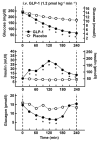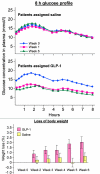New therapeutic strategies for the treatment of type 2 diabetes mellitus based on incretins
- PMID: 17491680
- PMCID: PMC1783553
- DOI: 10.1900/RDS.2005.2.61
New therapeutic strategies for the treatment of type 2 diabetes mellitus based on incretins
Abstract
Orally ingested glucose leads to a greater insulin response compared to intravenously administered glucose leading to identical postprandial plasma glucose excursions, a phenomenon referred to as the "incretin effect". The incretin effect comprises up to 60% of the postprandial insulin secretion and is diminished in type 2 diabetes. One of the very important gastrointestinal hormones promoting this effect is glucagon-like peptide 1 (GLP-1). It only stimulates insulin secretion and normalizes blood glucose in humans under hyperglycemic conditions, therefore it does not cause hypoglycemia. Other important physiological actions of GLP-1 are the inhibition of glucagon secretion and gastric emptying. It further acts as a neurotransmitter in the hypothalamus stimulating satiety. In vitro and animal data demonstrated that GLP-1 increases beta-cell mass by stimulating islet cell neogenesis and by inhibiting apoptosis of islets. In humans, the improvement of beta-cell function can be indirectly observed from the increased insulin secretory capacity after GLP-1 infusions. GLP-1 represents an attractive therapeutic principle for type 2 diabetes. However, native GLP-1 is degraded rapidly upon exogenous administration and is therefore not feasible for routine therapy. The first long-acting GLP-1 analog ("incretin mimetic") Exenatide (Byetta) has just been approved for type 2 diabetes therapy. Other compounds are being investigated in clinical trials (e.g. liraglutide, CJC1131). Dipeptidyl-peptidase IV inhibitors (DPP-IV inhibitors; e.g. Vildagliptin, Sitagliptin) that inhibit the enzyme responsible for incretin degradation are also under study.
Figures





References
-
- Zunz E, La Barre J. Contributions a l’étude des variatins physiologiques de la sécrétion interne du pancréas: relations entre les sécrétions externe et interne du pancréas. Arch Int Physiol. 1929;31:20–44.
-
- Creutzfeldt W. The incretin concept today. Diabetologia. 1979;16:75–85. - PubMed
-
- Creutzfeldt W. Entero-insular axis and diabetes mellitus. Horm Metab Res. 26(Suppl 1992):13–18. - PubMed
-
- Meier JJ, Nauck MA, Schmidt WE, Gallwitz B. Gastric inhibitory polypeptide: the neglected incretin revisited. Regul Pept. 2002;107:1–13. - PubMed
-
- Nauck MA, Homberger E, Siegel EG, Allen RC, Eaton RP, Ebert R, Creutzfeldt W. Incretin effects of increasing glucose loads in man calculated from venous insulin and C-peptide responses. J Clin Endocrinol Metab. 1986;63:492–498. - PubMed
LinkOut - more resources
Full Text Sources
